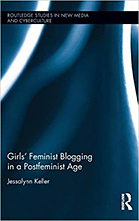Keller, Jessalynn - Girl’s Feminist Blogging in a Postfeminist Age, Routledge Series in New Media and Cyberculture, New York: Routledge, 2016, 191 pp. ISBN 978-1-138-80014-4 (hbk), 978-1-135-75563-2 (ebk)
Reviewed by Padma Priya - RMIT University
Keller, with an in-depth analysis of contemporary feminist identities and ideologies expressed through digital media, makes her book Girl’s Feminist Blogging in a Postfeminist Age a good read for the scholars interested in feminism and new media. The chapters are finely crafted and thematically arranged. There are seven chapters in total, two chapters and five numbered chapters. The first chapter is an introduction to the core theme and the final chapter a conclusion of the topics discussed while each of the numbered chapters discusses each varying aspects of post-feminism conveyed through online media.
The Introduction chapter presents the readers to Keller’s vision of ‘cultural interrogation’ (9) using the theoretical framework of cultural studies. The relationship of feminist identities and blogs form the core concept of chapter Click Moments and Coming Out, which explores the construction of female identities of bloggers through their blogs. Keller goes on to explain how blogs have helped young girls to articulate their feminist ideas. While it is the articulation of identity in Chapter 1, the transformation of the feminist identity into practicing feminist activities through blogging is the main focus in Chapter 2.
The next chapter, Loud, Proud, and Sarcastic discusses how feminist blogging communities facilitate a common connection through online network while the use of public space to advocate and promote feminism and feminist blogs by the blogging girls are discussed in Chapter 5. Different feminist issues in online spaces are discussed using case studies. The ‘relationship between the history of feminism and contemporary girl feminists blogging’ (114) is discussed in Chapter 4 by analysing the blogging practices. The final chapter Conclusion is all about the growth of new media feminist in the university campuses and scholarly world.
This book follows a definitive pattern. It firstly discusses the broader area of research then focuses on each theme and provides an overview of the author’s conclusion along with the topics and themes that could be examined in future studies. As the chapters move from one topic to the next, the author unveils different blogging aspects from a scholarly perspective. The research methodology adopted is also explicitly explained throughout the chapters.
The book explores the blogging practices of teenage girl bloggers in the US. Other online social media networks are also touched upon at various points. It is easy to see that the book is the outcome of an in-depth research in feminist ethnographic study in digital space. We cannot fail to notice the discussions of theories across various disciplines such as cultural studies, gender studies, media studies and so on along with the ethnographic approach followed throughout the book, as the topic of research is cross disciplinary. Multiple theories used in this study make this book unique as it could be of use to scholars across various disciplines. This book will also be helpful for students researching in these disciplines.
As this book is an offshoot of doctoral dissertation, it is not intended for general readers who are interested to gain a deep insight into feminism or blogging experiences of girls in the US. The feminist identities and representation discussed in this book might not be true of teenage bloggers from other countries or culture. However, the theories and ideas explored by the author could be helpful for researchers in the same field. Scholars exploring feminism in new media or technological determinism as well as cultural or gender studies, especially feminist and neo-liberal theorists will enjoy this book greatly.
About the reviewer
P. Padma Priya is a PhD student in the School of Media and Communication at RMIT University, Melbourne, Australia. Her research focuses on the impact of digital technology in academic publishing.

